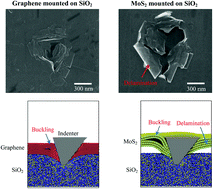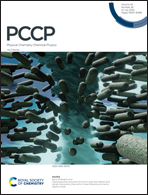Delamination of MoS2/SiO2 interfaces under nanoindentation†
Abstract
Molybdenum disulphide (MoS2) mounted on silicon dioxide (SiO2) constitutes the fundamental functional components of many nanodevices, but its mechanical properties, which are crucial for the device design and fabrication, remain almost unexplored. Here, the mechanical properties of the multilayer MoS2/SiO2 system are investigated via nanoindentation experiments and molecular dynamics simulations. In terms of the mechanical properties, a comparative study of MoS2/SiO2 and graphene/SiO2 systems is presented. The MoS2/SiO2 and graphene/SiO2 systems are found to possess comparable Young's modulus and hardness values, but their mechanical responses and failure modes under indentation are totally different. Interface delamination failure accompanied by ring-like through-thickness cracking is observed in the MoS2/SiO2 system with a relatively thin MoS2 layer, while no interface separation is found in indentation experiments for the graphene/SiO2 system using the same layer thickness. The different failure modes observed between the MoS2/SiO2 and graphene/SiO2 systems can be attributed to the comparable interface adhesion energy but very different bending stiffness values of the MoS2 and graphene components. Specifically, compared with graphene, the larger bending stiffness of MoS2 means that a larger bending force is experienced in the indentation process, overcoming the adhesion of the MoS2/SiO2 interface, which makes interface delamination much easier in the MoS2/SiO2 system.



 Please wait while we load your content...
Please wait while we load your content...